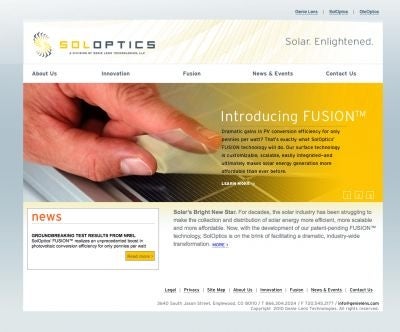A stick-on photovoltaic film developed by Soloptics can improve solar panel efficiency rates by over 12 percent, thereby reducing the cost of solar power for the consumer. The US Department of Energy confirmed the products' effectiveness on August 2.
Groundbreaking technology for improving the performance of solar panels has been developed by Soloptics, a division of Genie Lens Technology Group, a leading specialist in applied innovative optics.
Soloptics announced on August 2 that the US Department of Energy's National Renewable Energy Laboratory (NREL) confirmed that Soloptics' recently developed FUSION technology can improve the energy conversion efficiency of both new and existing photovoltaic (PV) panels by up to 12.5 percent.
The FUSION product is constructed using thin film polymer technology onto which microstructures are embossed; these microstructures provide increased light absorption and anti-reflective coatings. The thin film can be applied to PV cells much like a sticker, generating increased amounts of solar power even in poor weather conditions.
Increased energy conversion efficiency in PV cells would not only improve performance, but also reduce costs for the consumer. Therefore making house-mounted solar panels a more feasible and cheaper source of electricity. The film developed by Soloptics is attracting critical acclaim amongst solar technology professionals as it can be applied by householders themselves, which allows them to avoid the costly installation fees normally associated with solar technology.
Soloptics is expected to license the product to a large manufacturer, but no further details or expected retail prices could be confirmed.
Research and development of products which increase PV energy conversion efficiency is a highly competitive and rapidly evolving field. In June solar panel manufacturer JA Solar announced it was collaborating with Silicon Valley startup Innovalight to develop cells which achieve higher energy efficiency rates through use of a 'silicon crystalline ink.'
Subscribe to Independent Premium to bookmark this article
Want to bookmark your favourite articles and stories to read or reference later? Start your Independent Premium subscription today.


Join our commenting forum
Join thought-provoking conversations, follow other Independent readers and see their replies